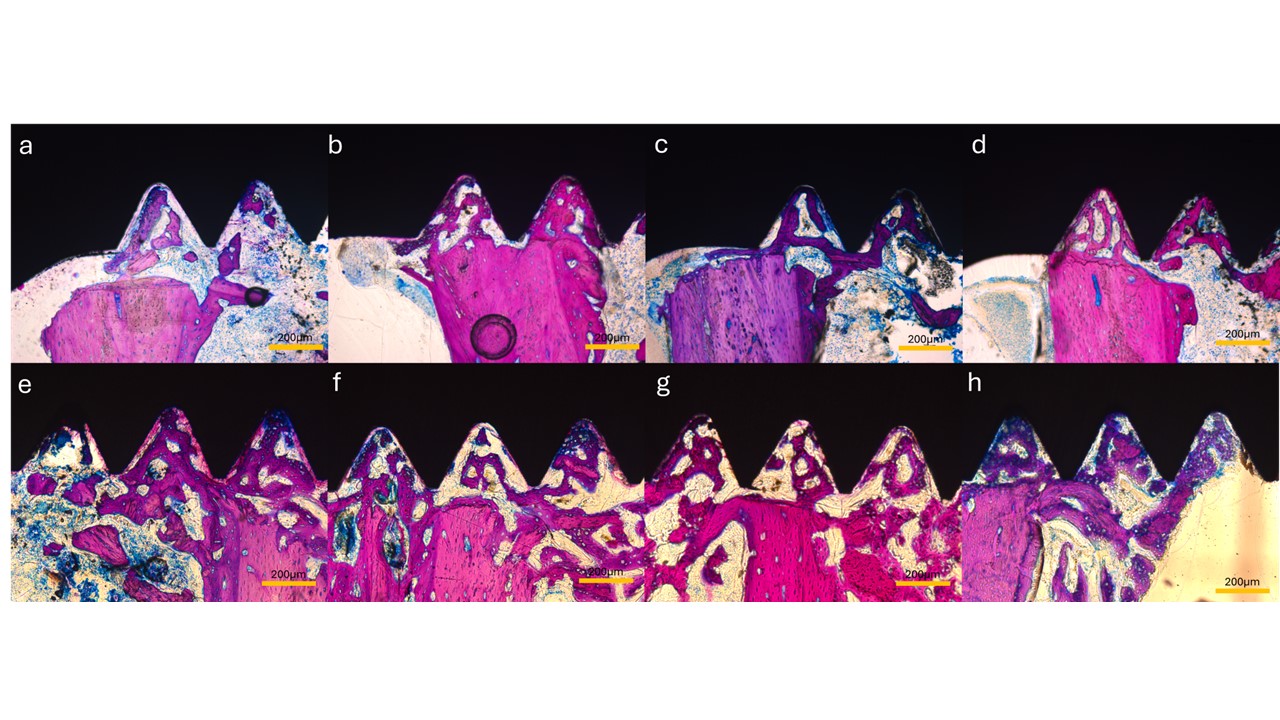Titanium micro-nano textured surface with strontium incorporation improves osseointegration
an in vivo and in vitro study
DOI:
https://doi.org/10.1590/1678-7757-2024-0144Keywords:
Osseointegration, Titanium implant, Dental implant, Strontium, Surface modification, Animal modelAbstract
Objectives: This study aimed to investigate the osseointegration of titanium (Ti) implants with micro-nano textured surfaces functionalized with strontium additions (Sr) in a pre-clinical rat tibia model. Methodology: Ti commercially pure (cp-Ti) implants were installed bilaterally in the tibia of 64 Holtzman rats, divided into four experimental groups (n=16/group): (1) Machined surface - control (C); (2) Micro-nano textured surface treatment (MN); (3) Micro-nano textured surface with Sr2+ addition (MNSr); and (4) Micro-nano textured surface with a higher complementary addition of Sr2+ (MNSr+). In total, two experimental euthanasia periods were assessed at 15 and 45 days (n=8/period). The tibia was subjected to micro-computed tomography (μ-CT), histomorphometry with the EXAKT system, removal torque (TR) testing, and gene expression analysis by PCR-Array of 84 osteogenic markers. Gene expression and protein production of bone markers were performed in an in vitro model with MC3T3-E1 cells. The surface characteristics of the implants were evaluated by scanning electron microscopy (SEM), energy-dispersive spectroscopy (EDS), and laser scanning confocal microscopy. Results: SEM, confocal, and EDS analyses demonstrated the formation of uniform micro-nano textured surfaces in the MN group and Sr addition in the MNSr and MNSr+ groups. TR test indicated greater osseointegration in the 45-day period for treated surfaces. Histological analysis highlighted the benefits of the treatments, especially in cortical bone, in which an increase in bone-implant contact was found in groups MN (15 days) and MNSr (45 days) compared to the control group. Gene expression analysis of osteogenic activity markers showed modulation of various osteogenesis-related genes. According to the in vitro model, RT-qPCR and ELISA demonstrated that the treatments favored gene expression and production of osteoblastic differentiation markers. Conclusions: Micro-nano textured surface and Sr addition can effectively improve and accelerate implant osseointegration and is, therefore, an attractive approach to modifying titanium implant surfaces with significant potential in clinical practice.
Downloads

Downloads
Published
Versions
- 2024-10-01 (2)
- 2024-09-16 (1)
Issue
Section
License
Copyright (c) 2024 Pio Moerbeck da Costa Filho, Camila Chiérici Marcantonio, Diego Pedreira de Oliveira, Maria Eduarda Scordamaia Lopes, Julio Cesar Sanchez Puetate, Luan Viana Faria, Letícia de Freitas Carvalho, Rafael Scaf de Molon, Idelmo Rangel Garcia Junior, Andressa Vilas Bôas Nogueira, James Deschner, Joni Augusto Cirelli

This work is licensed under a Creative Commons Attribution 4.0 International License.
Todo o conteúdo do periódico, exceto onde está identificado, está licenciado sob uma Licença Creative Commons do tipo atribuição CC-BY.

